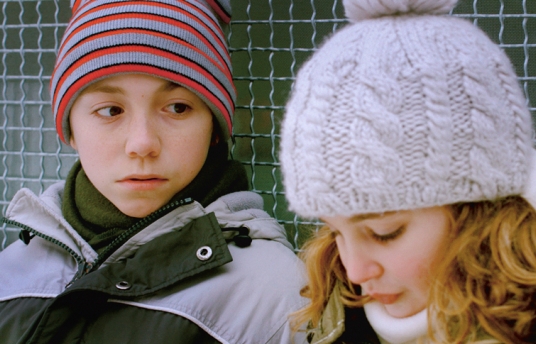DFI Film Review: Monsieur Lazhar
Mar 10, 2013

By Alexander Wood
A wintry school day begins like any other, as children roughhouse with their classmates in a snow-covered playground somewhere in Montreal. The beauty of the white snow and colourful jackets fades away to introduce us to the captivating Marie-Frédérique (Marie-Ève Beauregard) and Simon (Émilien Néron) who chat and share food from the pockets of their winter coats. Simon rushes off to fulfill his classroom duty of handing out milk when he discovers a tragedy that resonates throughout the entire school.
The vibrant, humorous, and magnetic personalities of the students are set against a backdrop of tragedy as they struggle to remain their playful selves while dealing with issues that should be beyond their years. The initial scene with Marie-Frédérique and Simon sets the tone of the film through their youthful and articulate banter, smiles and body language. The use of cinematography offers a firsthand glimpse into their lives and the lives of the other students. Low camera angles allow us to see the world through their eyes; be it the school, playground, or the personal items hidden inside their desks. Close-ups and handheld camera work provides a real sense of intimacy that allows us to not only empathise with the children’s struggles but cherish the authenticity of their emotions. Director Philippe Falardeau’s film creates a beautiful slice of life, which is exposed to the viewer slowly through the cinematography and pacing of the narrative.
Many of the scenes within the film are shot through a window or fence looking into the intimate spaces of the school or playground. Even the opening shot of the film ensures that viewers look into the snowy playground before becoming a part of it. These visual barriers between the audience and the students make the viewer an outsider who is constantly challenged to empathise and understand the children, while slowly being inducted into their tightly knit society.
Our experience while watching the film is much like that of M. Lazhar (Fellag), who arrives in order to teach the students, making the best of the situation and his old-school teaching style. As an Algerian refugee, M. Lazhar is very much an outsider who slowly finds his way into the lives of the children. The number of shots showing him looking into the courtyard through a window or standing on the periphery greatly decreases as his relationship with the students transforms.
M. Lazhar moves from the outside world into the interior of the school by gaining the trust of his students. One of the most moving scenes is when he joins the children in their English class in an attempt to expand his vocabulary. Within the scene he is sitting at the back of the classroom at a desk like his students, blending two worlds and allowing M. Lazhar to become one of them as he too is now being taught.
This mirroring of worlds can be seen as M. Lazhar is also coming to terms with a heartrending tragedy of his own, the dreadful nature of which he keeps to himself, and which colours his every action. The lives of the students and M. Lazhar are paralleled in many scenes throughout the film, which further fuse them as both experience nightmares, emotional outbursts, and use photographs to preserve memories of people they have lost.
The ideas of transformation and tragedy are central to the film’s movement; one which begins in the lifelessness of winter and transition towards the reawakening of life that spring ushers in. Falardeau creates a complex study of loss and heartbreak, healing and love. Touching, charming, eloquent – and often very funny – it shows us that coming to terms with tragedy, whatever its magnitude, is a shared journey.
If you would like to experience this award-winning film, it is screening as part of DFI’s Francophone Cinema Showcase. Please click here for more details.